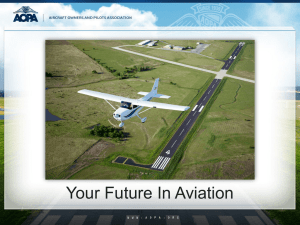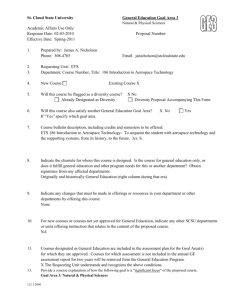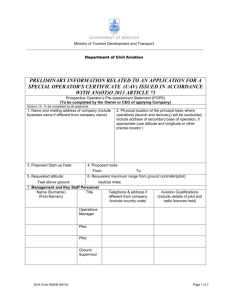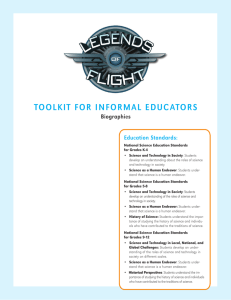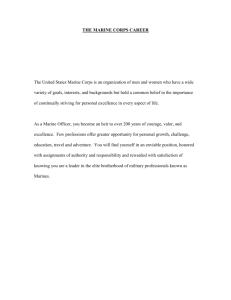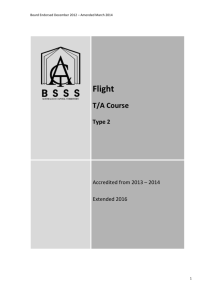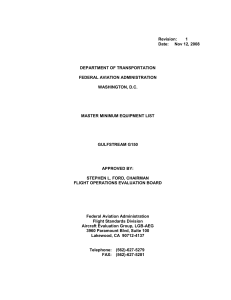GE-10-141. AVIT 101. Aeronautics I
advertisement
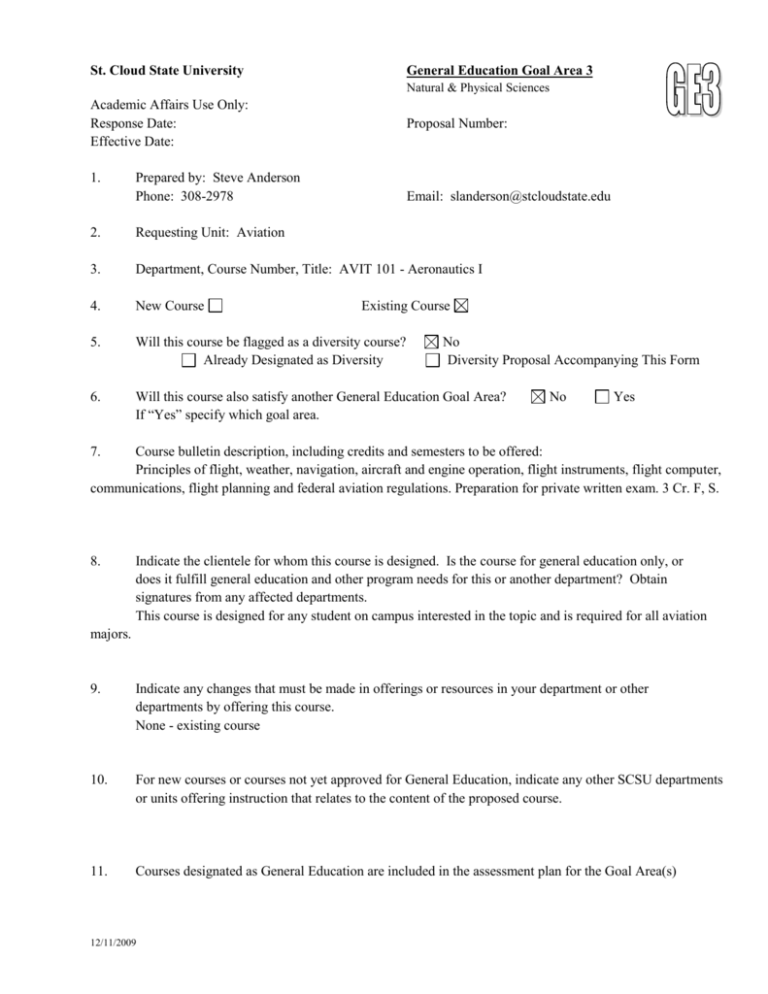
St. Cloud State University General Education Goal Area 3 Natural & Physical Sciences Academic Affairs Use Only: Response Date: Effective Date: 1. Proposal Number: Prepared by: Steve Anderson Phone: 308-2978 Email: slanderson@stcloudstate.edu 2. Requesting Unit: Aviation 3. Department, Course Number, Title: AVIT 101 - Aeronautics I 4. New Course 5. Will this course be flagged as a diversity course? Already Designated as Diversity 6. Will this course also satisfy another General Education Goal Area? If “Yes” specify which goal area. Existing Course No Diversity Proposal Accompanying This Form No Yes 7. Course bulletin description, including credits and semesters to be offered: Principles of flight, weather, navigation, aircraft and engine operation, flight instruments, flight computer, communications, flight planning and federal aviation regulations. Preparation for private written exam. 3 Cr. F, S. 8. Indicate the clientele for whom this course is designed. Is the course for general education only, or does it fulfill general education and other program needs for this or another department? Obtain signatures from any affected departments. This course is designed for any student on campus interested in the topic and is required for all aviation majors. 9. Indicate any changes that must be made in offerings or resources in your department or other departments by offering this course. None - existing course 10. For new courses or courses not yet approved for General Education, indicate any other SCSU departments or units offering instruction that relates to the content of the proposed course. 11. Courses designated as General Education are included in the assessment plan for the Goal Area(s) 12/11/2009 for which they are approved. Courses for which assessment is not included in the annual GE assessment report for two years will be removed from the General Education Program. The Requesting Unit understands and recognizes the above conditions. 13. Provide a concise explanation of how the following goal is a “significant focus” of the proposed course. Goal Area 3: Natural & Physical Sciences Explore scientific knowledge of the natural world. Understand the central concepts and principles of science; experience the process of scientific inquiry; comprehend science as a human endeavor and understand the impact of science on individuals and on society. This long standing general education course is an applied science course that requires students to understand the concepts, theories, and principles of many science desciplines such as math, physics, chemistry, and meteorology and apply them to practical situations. In this courses students see how the concepts, theories, and principles of other scientific disciplines work through the study of topics such as aerodynamics, weather, aircraft performance, and navigation. Students also learn how to make decisions relative to safe aircraft operations using these scientific concepts which requires an understanding of the process of scientific inquiry, human impact on science, and the real impact of science on themselves and others as applied in aviation. 14. In order for a course to be designated as fulfilling Goal Area 3, it must address at least 5 of the 6 student learning outcomes (SLOs) below. Check the SLOs below that are focused on in the proposed general education course. 1. Demonstrate knowledge of concepts, principles, and theories in the physical or natural sciences. 2. Make observations and collect data, design and carry out experiments or other types of scientific investigations. 3. Formulate research questions and testable hypotheses, analyze and interpret data, draw inferences and conclusions, and identify further questions for investigation. 4. Demonstrate awareness of the interdependent relationships of basic science, applied science, mathematics, and technology. 5. Recognize the human nature of the scientific enterprise, including the importance of curiosity, creativity, and imagination; the dual nature of scientific knowledge as changeable and durable; and the impact of a scientist's personal identity on the scientific process. 6. Evaluate societal issues from a science perspective, question the evidence presented, and make informed judgments about these issues. 15. Discuss how each Student Learning Outcome checked above is achieved in this course. (Note: Although descriptions of typical assignments or types of assignments may be part of this discussion, it is not appropriate to submit copies of actual assignments.) SLO 1. Students have many assignments, demonstrations, problems, and test questions related to achieving this SLO. For example, students must demonstrate an understand of the physics and aerodynamic principles involved in how an airplane flies through both assignments and demonstrations and students learn about weather theory through assignments and demonstration in order to accurately interrupt weather data to learn how to make safe decisions regarding flight. SLO 2. Examples of achieving this SLO include making observations and collecting weather data and determining if conditions are safe for a flight and collecting information to determine aircraft performance information. 12/11/2009 SLO3. Examples of achieving this SLO include formulating questions regarding the ability of an aircraft to operate at specific airports and collecting and analyzing aircraft performance information to determine if the aircraft can safely operate at those specific airports. Students also must develop questions about what type of weather conditions are safe for a flight and analyze and interrupt weather data to determine if the flight can be made with those weather parameters. SLO4. As an applied course this relates to the majority of the course topics. Students learn and demonstrate understanding of concepts, theories, and principles of many science disciplines such as math, physics, chemistry, and meteorology and how they apply in practical situations. For example, students are involved in exercises in understanding how concepts of physics, chemistry, and mathematics work together to form various weather phenomena and that can impact the flight environment, the aircraft, and its related technology. SLO5. Through exercises and assignments on topics such as aerodynamics, airplane design, and navigation theory the students learns how human curiosity, creativity, and imagination has expanded human understanding and improved the technologies in those areas. SLO6. Students must evaluate items, such as the environmental impact, of aircraft operations on others during exercises on flight planning and must collect and analyze information in order to make informed judgments on how to minimize the any negative impact. 16. Courses satisfying Goal Area 3: Natural & Physical Sciences must have either a “traditional lab course or a lab-like experience”. Check which of these apply and supply a brief explanation of how the course is either a laboratory course or incorporates a “lab-like experience”. Course includes: Laboratory Lab-like experience The following quote from a National Research Council subcommittee report may help to identify a course with a laboratory. ”Laboratory experiences provide opportunities for students to interact directly with the material world (or with data drawn from the material world), using the tools, data collection techniques, models, and theories of science.” America's Lab Report: Investigations in High School Science (Free Executive Summary) http://www.nap.edu/catalog/11311.html This course incorporates lab-like experiences through having the students individually and in small groups conducts exercises in such topics as collecting and analyzing aircraft proformance information, collecting and analzing weather data and applying this information in planning cros country flight operation. 17. • • • • • • • • • • List or attach the Course Outline (adequately described and including percentage of time to be allocated to each topic). Curriculum Committees may request additional information. Topics larger than 20% need to be broken down further. Indicate in your course outline where the Student Learning Outcomes checked above are being met. As an applied science course all the SLOs are covered to some extent in all the topic areas. Airplane Systems - 10% Aerodynamic Principles - 15% The Flight Environment - 5% Communication and Flight Information - 5% Meteorology for Pilots - 10% Interpreting Weather Data - 10% Federal Aviation Regulations - 8% Airplane Performance - 12% Navigation theory and application - 15% Applying Human Factors Principles - 10% 12/11/2009 12/11/2009 St. Cloud State University General Education Transmittal Form Academic Affairs Use Only: Response Date: Effective Date: Proposal Number Department: Aviation Course or Course(s): AVIT 101 Aeronautics I Department or Unit Chair Signature Date Department forward to Academic Affairs for publication and electronically to Chair of General Education Committee, Chair of College Curriculum Committee, College Dean Recommendation of General Education Committee: Approve Remarks: Disapprove Chairperson Committee Signature Date Recommendation of University Curriculum Committee: Approve Remarks: Disapprove Chairperson Committee Signature Date Recommendation of Faculty Association: Approve Remarks: Disapprove FA Senate Signature Date Action of Academic Vice President: Approve Disapprove Signature Entered in Curriculum Data File 12/11/2009 Remarks: Date




